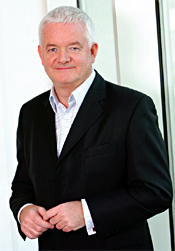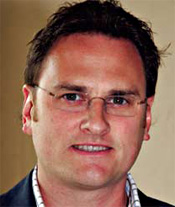|
| GOODBYE 2008 HELLO 2009!
 | |
|
 | |
| Dan Warren, director of technology at the GSM Association
|
| 2008 has been a lively year for the mobile industry, and 2009 looks like it will be just as eventful. Here, Heather McLean asks what the industry feels have been the highs and lows of 2008, and what is coming next.
Darren Griffiths, managing director at High Peak Mobiles, sums up how he feels at the end of 2008, looking forward to another 12 months: “We would be wrong to say that it has been a breeze. 2008 has been a tough one. We have seen UK banks merge and fall apart and a housing market that seems to have collapsed on its feet, so to stand here and prove that we are still here despite all of this seems to be an accomplishment in its own.”
Economic challenges
The most important trend of 2008 is the economic one, agrees 20:20 managing director, James Browning. He says that at the moment, the prospects for 2009 are a ‘known unknown’. “What I mean is, we know the credit crunch and economic slowdown will knock the wind of our sails, but we don’t yet know to what degree. Will be short and shallow or long and deep? And of course it’s a global problem. And as a relatively new industry, which hasn’t experienced a
|
| proper recession before, there’s an added element of the unknown for us all,” he adds.
Times are changing for dealers, as operators reassess payment models. Gamma expects to see greater consolidation in the channel as more mobile operators follow O2’s move to eliminate upfront commissions for channel partners in exchange for ongoing revenue, comments Gamma Telecom’s Rob Davis, senior product manager. “This is a big change for many channel partners and they either need to roll over and accept the pricing policies imposed by the major network operators, or move to a mobile provider that gives them greater control over their customers and mobile pricing.”
Browning states that innovation and resilience will be the key attributes needed to weather the financial storm that will be accompanying businesses into 2009. He comments: “The hope must be that 2009 isn’t a year long hangover. As Bill Clinton’s campaign slogan put it, ‘It’s the economy, stupid’. Are we coming out of a downturn, or still stuck in one? Most economists seem to think the recession will be less severe than those over the last three decades. But there are always the naysayers who predict a more severe slowdown. Whichever it is, I would predict most of 2009 will feel flat with money tight and many consumers making do with their existing phones that bit longer. For those looking for a new deal they will find a buyer’s market waiting for them. There’s nothing like a serious downturn to drive out a bargain!”
20:20 has undergone some pretty big changes over the year, including the refinancing of the business and its organisational restructure of the merging of its UK operations and move to expand overseas. Another change has been the arrival the new 20:20 group CEO, Meinie Oldersma, who’s had a galvanising effect on the business. 20:20 also managed to retain Approved Partner status with Nokia for both handsets and accessories. “So, in many ways, we end 2008 as a stronger, more stable and more focused business than we entered it,” states Browning.
|
| |
| Mobile Broadband
|
| Throughout 2008, the growth of mobile broadband services across the globe has been a key feature that has amazed Dan Warren, director of technology at the GSM Association. High speed packet access (HSPA) has been adopted faster than any other mobile technology and it is having a fundamental impact on operator business models, data usage and end user behaviour, which will shape the industry for years to come, he claims. He adds that mobile broadband is delivering services to markets that are simply not reached by fixed line broadband infrastructure, and delivering major social and economic benefits.
Peter Rampling, marketing director at O2 UK, states that this year the industry has seen all of the operators launch mobile broadband packages. “We launched our own mobile broadband package in April offering a complete communications experience to all of our customers. Whether you are a business or an individual, you can now stay connected however you want, via your mobile, home or even with mobile broadband.”
Martin Lyne, director of small business at Orange Business, says: “The overall positive of 2008 is that as an industry we are getting better at delivering devices and services that address specific end user needs. Mobile; broadband is now becoming a device norm, so rather than simply competing on speed, we can begin to deliver exceptional end user advantages by combining speed and functionality to address specific user needs.
“A great example of this is the introduction by operators of laptops into product portfolios. In particular, I see embedded laptops, where the USB is included in the laptop for instant connectivity as a turning point for the industry and our customers,” Lyne added. Going forward, Orange will focus on more growth with mobile broadband. Lyne says: “Our focus for 2009 remains on retaining our existing customer base while attracting new quality connections. Our partner network will play a fundamental role in helping us achieve this goal and we will be working with them to develop long term profitable relationships. Connected laptop and mobile broadband will continue to be a focus area of growth but, of course, we will remain committed to providing our voice customers with a high quality service at a competitive price.”
Technologically, the rise of long term evolution (LTE) from being a paper exercise to a demonstrable technology is a major positive for the future of mobile broadband, adds Warren. “The progressive work on LTE in 3GPP looks like the GSM family will be further extended beyond the 85% of the market that is already encapsulated, and LTE will be delivering the next step in bandwidth beyond what HSPA and HSPA+ offers. Now that the technology is being demonstrated in labs and field trials, it seems certain that widespread adoption will take place in the years to come.”
2009 can only build on what 2008 has delivered, states Warren. He expects higher mobile broadband data rates, increased diversification of services and applications, and, as a result, an ever increasing number of end users experiencing new mobile services of some kind.
|
| |
| Mobile Services
|
| |
| 2008 has been a fantastic year for the mobile industry, enthusiastically states Ben Dowd, business sales director at O2 UK. “At O2, we’ve continued to work hard to offer all of our customers an outstanding experience. This year we have focused our energies on our customers to ensure we understand the ins and outs of their business. With this in depth knowledge, we are able to provide them with a personal mobile communications package. In the small and medium business market we have restructured to take a regional approach to our customers. This has helped gain deeper insight into our customer needs and has also enabled our direct and indirect sales teams to work much closer together to drive the very best customer experience.”
In the mobile payments space, The O2 Wallet trial between November 2007 and May 2008 tested consumer demand for having cards would normally be carried in a wallet, such as Oyster and credit cards, available on the Nokia 6131 NFC mobile phone. Contactless payments facilitated by card schemes such as Visa Paywave and Mastercard Paypass have been a key trend that has grown rapidly over the course of 2008, and one that looks set to continue to grow.
Over 2009, O2 will work to build on NFC projects, states Claire Maslen, head of near field communications at O2 UK: “We are investing heavily in continuing to build our NFC model. We will be creating an industry taskforce to bring together mobile operators, handset manufacturers and key players from the
 | |
|
 | |
Gamma Telecom’s Rob Davis, senior product manager |
|
transport and finance sectors to form the foundations for commercial NFC on mobile services. By working together, the consortium will have a shared vision of what commercial services will look like, how operational issues can be tackled and together, it will identify any barriers for adoption.” | |
| |
| Travelling Trends
|
| |
| From the handset maker’s point of view, John Barton, sales and marketing director for LG’s mobile division in the UK and Ireland, states the eight megapixel camera phone was one of the most notable hits of the year. Barton adds that advances in touch technology have been evident this year and touchscreens have become a key feature for many high end handsets. He says LG was the first manufacturer to develop a full touchscreen handset with the PRADA Phone, and has since been advancing this technology in new models such as the LG Renoir. Most recently, LG has launched the LG Cookie, an affordable full-touchscreen handset, which opens up this technology to a broader range of users.
There are two huge trends that have seemed to have a particularly large impact on the market, says Darren Pattie, UK channel business director at Avaya UK. Firstly, the blurring of consumer and corporate mobile communications methods. “I know it’s an idea that’s been bandied about for a while, but the release of the iPhone triggered a reaction that the BlackBerry never quite sparked, and now the tide has really changed and businesses have been forced to respond.”
Pattie continues: “Also, flexible working. There’s been a huge increase in demand for flexible working options, partly because people are becoming accustomed to using technology at home that they realise could easily allow
 | |
|
 | |
John Barton, sales & marketing director for LG’s mobile division in the UK & Ireland |
|
them to work flexibly. We don’t expect this demand to slow; more businesses will allow their employees to work flexibly, using a BlackBerry and home broadband, and a logical next step from that will be to expand with a full unified communications strategy suitable for their type of business.” | |
| |
| iPhone fever
|
| |
| Increasing, time pressure combined with an insatiable demand for productivity is driving mobile technology to overcome boundaries in a way that can only transform business, states Oliver Chivers, head of business marketing at T-Mobile UK. “We are currently in the midst of a mobile internet explosion. Nokia Siemens believes that mobile traffic will increase a hundredfold by 2015, by which point 70% to 90% of the world’s internet traffic will be handled via mobile connectivity. The industry expects mobile data usage to overtake fixed usage by 2012. T-Mobile maintains that whilst it’s possible to estimate market growth, the reality is it will always be ten times greater.”
Chivers continues: “As the industry continues to manufacture tailored devices for the business market, the concept of carrying a PC in your pocket has become a reality. This power and functionality in a handheld device is whetting business appetite for the latest services. We have seen huge advancements in the past year, particularly in the form of the Apple iPhone and T-Mobile’s collaboration with Google in the G1, which have broken boundaries in terms of innovation and functionality.”
The launch in Europe of the Apple iPhone demonstrates how an innovative new interface can transform peoples’ expectations of how the internet can be harnessed by the mobile phone, says Chivers. “The publicity around the iPhone has increased consumer awareness of and demand for the mobile internet, giving operators and manufacturers the added momentum to deliver rich differentiated offerings to market. For instance, in 2009 we can expect to see e-money make its commercial debut, the rise of navigation and mapping on phones, and a raft of new services to mobilise access to users’ personal and social networks.”
Derek McManus, chief technology officer at O2 UK, added: “The mobile internet space has been transformed by the introduction of the iPhone and we don’t believe that there is a limit to people’s appetite for data. In fact, a study earlier this year by M:Metrics revealed that more than 80% of iPhone users in France, Germany and the UK used their device to browse online, compared to just 10% in the rest of the mobile phone market. A further study from analysts iSuppli showed that iPhone users spend 12% of their time on their handset browsing the web compared to just 2.4% of time spent by other mobile phone users.”
LG’s Barton comments on the trends he expects to see in handset design over the next year: “There is no doubt that the iPhone has had an impact in the way the public views the mobile phone, and the expectation that intuitive touchscreen menus should be given will be met by more successful vendors. In short, Apple will be overtaken by such manufacturers in this respect, both
 | |
|
 | |
Derek McManus, chief technology officer at O2 UK | |
| |
 | |
Claire Maslen, head of near field communications at O2 UK |
|
| by virtue of the speed and style in such input methods. There are a number of trends that we will see evolve throughout 2009, such as music, operating systems, software applications and mobile music downloads.”
Developments in the smartphone market have been a major positive in 2008 agrees Peter Kelly, director of enterprise at Vodafone UK. He says the iPhone stirred things up initially, but now that other operators and manufacturers, such as Vodafone and RIM, have combined, the smartphone battle is really on.
|
| |
| IMS impasse?
|
| |
| Matt Hooper, chief marketing officer at Celona, provider of business centric application data migration software, says 2008 has improved the mobile experience for end users, as the emergence of the iPhone has forced device vendors to step up with strong advances in user experience. However, he adds: “Service providers continue to struggle with mobile service silos and how to provide the user with a truly unified experience, especially in terms of services such as messaging. There is also still much work to do in terms of pricing and billing transparency for users who are still getting caught out through lack of clarity from their service providers. Also, in many cases, areas such as data migration are in some instances delaying operators’ transformation programmes due to complex data management issues and legacy business applications that can be difficult to upgrade.”
Yet in spite of the need to unify infrastructure, a trend seen in 2008 was the wane in enthusiasm for IMS, states Jonathan Bell, vice president of product marketing at OpenCloud, a real time application server provider. “A few years ago it was impossible to go anywhere without that ubiquitous three letter acronym appearing prominently in conversation. But fast forward three or four years to 2008 and most commentators now agree that widespread commercial deployment of this architecture won’t happen until 2012 at the earliest.”
The economic slow down is one reason IMS is no longer a hot topic, says Bell. “Most operators have been restricted by the ongoing legacy barriers imposed by proprietary lock-in and the high cost development environments in these service layers, but are unable to move due to the substantial switching costs involved.”
Because of this, 2008 has seen a universal acceptance that TDM networks will be here for a long time yet, continues Bell. “We can now get back to the serious business of taking costs out of the current infrastructure and creating the agile telco on SS7, today. This is why the launch of Rhino 2.0 and JSLEE 1.1 were also important events of 2008. These opened the market up to third party application developers, which can develop genuinely portable applications for multiple customers.”
Yet there is still a need to pull everything together for the operators, says Hooper. “The ramp up of transformation projects across operators has far reaching implications for the industry and will drive success for operators in the future. Transformations should make operators more agile, more customer-focused and with an opportunity to remove many of the operational service silos that have always limited operators in their ability and speed with which they execute.”
Yet Warren says he hopes IMS will make a come back in 2009. From a GSMA perspective, one of the key deliverables in 2009 will be the commercial and technical realisation of IP interconnection using the IPX model, states Warren: “Moving to an intelligent, pragmatic, and industry-wide interconnect system based on IP makes good operational sense, and 2009 will be the year when that happens.
“I would love to see 2009 be the year that IMS starts to be properly adopted,” continues Warren. “The growing momentum behind the Rich Communications Suite [RCS is an industry effort focused on the use of IMS for providing mobile phone communication services], which will enable mobile users to see at a glance whether their contacts are available to talk or exchange instant messages, easily initiate chat sessions or exchange pictures or videos during
 | |
|
 | |
Darren Pattie, UK channel business director at Avaya UK | |
| |
 | |
Oliver Chivers, head of business marketing at T-Mobile UK | |
| |
 | |
Matt Hooper, chief marketing officer at Celona, |
|
| a voice call, suggests that IMS is rising up the agenda.
“However, all of this must be tempered against the general slow down of the global economy. Investment decisions in both the operator and vendor community will be affected as resources become tight,” sums up Warren.
|
| |
| REGULATION
2008 has seen the advent of more regulation across the mobile industry, says Mark Weait, regional director for northern EMEA at mobile messaging specialist, Sybase 365, which he welcomes. “More aggressive endorsement of regulatory practice from bodies such as Phonepay Plus, and the tightening of regulations to ensure more responsible mobile services are being run across Europe. This is helping the image of mobile messaging, in terms of developing a sense of responsibility, and paved the way for the adoption of corporate services such as mobile payment and mobile banking.”
From the fixed line perspective, more regulation of mobile operators is required, says Gamma Telecom’s Rob Davis, senior product manager: “A major negative is the continued reluctance of Ofcom to reduce mobile termination charges significantly beyond the modest reduction that it is currently imposing on the mobile operators. Although Ofcom has announced another consultation on this issue, the high costs of terminating calls on mobile networks mean that the benefits of the true converged fixed mobile solution cannot be deployed cost effectively as quickly as we would all like.”
Yet the GSMA disagrees with the added regulatory interference of 2008, says Dan Warren, director of technology at the GSM Association. “At the GSMA, we are very concerned about the growing tendency for the European Commission to interfere and potentially distort the European mobile market. In 2008, the Commission has produced proposals to extend the EU roaming regulation to cover text messages and data services. This is particularly disappointing as market forces are driving prices down sharply as more people use mobile broadband services.
“This kind of intervention, which can deter investment, isn’t necessary in a very competitive and fast growing market,” adds Warren. “Market forces should determine the prices that people pay to use these services, just as they do in every other sector where there are several players competing for customers.”

Mark Weait, regional director for northern
EMEA at mobile messaging specialist,
Sybase 365
|
| |
|










